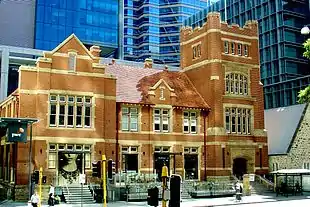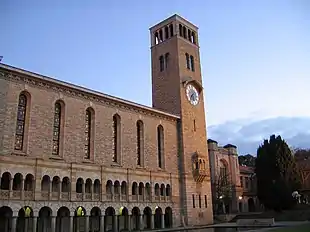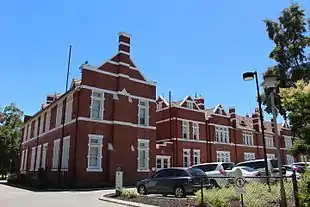Education in Western Australia
Education in Western Australia consists of public and private schools in the state of Western Australia, including public and private universities and TAFE colleges. Public school education is supervised by the Department of Education,[2] which forms part of the Government of Western Australia. The School Curriculum and Standards Authority is an independent statutory authority responsible for developing a curriculum and associated standards in all schools (public and private), and for ensuring standards of student achievement, and for the assessment and certification according to those standards.[3]

Western Australia follows a three-tier system, consisting of primary education (primary schools), followed by secondary education (high schools or secondary colleges) and tertiary education (Universities and TAFE Colleges).
Education is compulsory in Western Australia between the ages of six and seventeen. From 1 January 2008 persons in their 17th year must be in school, training, or have a job until the end of that year.
History
The first schools started to appear during the 1830s throughout the state, in the form of one-teacher schools. The oldest government-sponsored education institution in Western Australia, Guildford Colonial School (now Guildford Primary School), was founded at the Swan River Colony in 1833, and consisted of several premises in the townsite before a purpose built school was constructed in 1870.[4] From the 1850s schools became more common around Western Australia, with many of the teachers being sourced from educated convicts who had obtained their ticket of leave. Initially there were no official qualifications required to teach, only that a teacher be literate, and many schools were run by nuns or single women.
The first school in the state with a focus on educating Indigenous children, Annesfield, was opened in 1852 by clergyman John Wollaston and Anne Camfield in Albany.[5][6]

A royal commission in September 1910 proposed that a university be established in Western Australia.[7] Following this recommendation, the establishment of the University of Western Australia in 1911 by an act of the Parliament of Western Australia meant students could begin receiving tertiary qualifications in the state.[8] UWA opened to students two years later.
In 1915 James Miles chose Toodyay school to be the pioneer of his Special Rural Schools programme. To this end he worked with the headmaster Roderick Brooke Cowden[9] and his staff to design the equipment needed to enable the students to be more independent and resourceful in the learning process. Subjects were to be based on the practical activities of farming life. School gardens were established where the children experimented with different types of grains such a wheat, oats and barley, and the growing of vegetables and flowers. Girls were taught fruit and vegetable preservation, and first aid. When teaching standard curriculum subjects such as arithmetic and history, teachers were encouraged to use local sources, for example "figures showing the district's imports and exports were computed from the railway records".[10]:58 By 1920 twelve other special rural schools were established in the state. This number peaked at 40 in 1922. This success was in no small part due to the government's recognition of the state's dependence on agriculture. The commissioners of the Royal Commission into Education 1921 visited Toodyay and were highly impressed with its programme.[11]
Students in Year 11 and 12 initially undertook a Tertiary Admittance Exam for each subject, and a score was established based almost entirely on the results of a single exam from each of six subjects over the two years. From 1989 the Tertiary Entrance Exam (TEE) was the standard academic examination for students completing their twelfth year of schooling,[12] which was used to determine a student's Tertiary Entrance Rank (TER). In 2010 it was renamed to produce an Australian Tertiary Admission Rank (ATAR), a move towards a more national approach to students eligibility for tertiary study.[lower-alpha 1][13] Students satisfactorily completing Year 12 secondary education receive a Western Australian Certificate of Education.[14]
Primary and secondary education
Kindergarten and preschool
In Western Australia, children can start their education in Kindergarten, however compulsory schooling starts the following year in Pre-primary.
Preschool Pre-primary, was made compulsory in 2013. Before that time, many children were attending pre-primary education programs, but the government of Western Australia put in place legislation to bring the state into line with other jurisdictions.[15]
Early childhood educators in Western Australia follow the Australian Government and the School Curriculum and Standards Authorities guidelines on Early Learning. Many schools have adopted the Early Years Learning Framework, part of the National Quality Framework for Early Childhood Education, which focuses on Belonging, Being and Becoming.[16][17]
Primary schools
Primary education consists of six grades: a preparatory year (commonly called "pre-primary") followed by Years 1 to 6. The minimum age at which a child can commence primary school education is 4.5 years. That is, the child can enrol in a school at the preparatory level if he or she would be five years of age by 30 June of that year. A child must commence education before age six.

Secondary schools
Students in the Western Australian school system attend a secondary school from years 7 to 12. The age that a student begins secondary school was lowered in 2015, to begin at Year 7.[18][19] The government of Western Australia believes that a secondary school is more appropriate for young adolescents from Year 7 to assist with social and emotional development, and also assists in the delivery of the Australian Curriculum to Year 7 students.[20] Some institutions in Western Australia have an integrated primary and secondary school, educating students from Kindergarten to Year 12, while a number of private schools may operate separate middle schools for students in years 7 to 9 exclusively, with students in years 10 to 12 attending a senior school. This is normally within the same institution.
Gifted education and specialist programs
A number of public secondary schools have specialist programs for gifted and talented students. Perth Modern School is Western Australia's only public academically selective school, and entry is based on an Academic Selective Entry Test.[21] John Curtin College of the Arts in Fremantle, offers students in the public system the only arts based selective learning experience in the state, with enrolment to programs such as media arts, music, dance and drama available through a talent and aptitude test.[22] Canning Vale College has the state's only circus course along with a specialist art program, and Governor Stirling Senior High School has a specialist Australian rules football academy.
Selective Academic Program
The Selective Academic Program is a program in some public schools in Western Australia that provides further opportunities for gifted and talented students in English, humanities, mathematics and science. A key part of this program is extension activities that can include participation in state, national and international competitions, leadership programs and exposure to university programs.[23] The Selective Academic Program is accelerated and differentiated to support the needs of gifted and talented students.
Participating schools
- Bunbury Senior High School
- Comet Bay College
- Duncraig Senior High School
- Fremantle College
- Governor Stirling Senior High School
- Kelmscott Senior High School
- Melville Senior High School
- Online for country students
- Shenton College
- Willetton Senior High School
Curriculum
The curriculum in Western Australia is developed by the School Curriculum and Standards Authority. The Authority is also responsible for maintaining school standards and managing national literacy and numeracy testing through the National Assessment Program – Literacy and Numeracy.[24] The Western Australian curriculum is broadly consistent with the Australian Curriculum, but is contextualised for Western Australia students and teachers.[25] Secondary students in years 11 and 12 are enrolled in the Western Australian Certificate of Education program.
Australian Tertiary Admissions Rank
The Australian Tertiary Admissions Rank (ATAR) was introduced in 2010 in all states of Australia except Queensland as a means of standardizing the national university entrance system. The ATAR system follows the same principles as the systems that it replaces and improves upon them by allowing for greater interstate comparison of student achievements.
Tertiary pathways
The classification of tertiary qualifications in Western Australia is governed in part by the Australian Qualifications Framework (AQF), which attempts to integrate into a single national classification all levels of tertiary education (both vocational and higher education), from trade certificates to higher doctorates.
Technical and Further Education
Technical and Further Education (TAFE) institutes are state-administered. TAFE institutions generally offer short courses, Certificates I, II, III, and IV, Diplomas, and Advanced Diplomas in a wide range of vocational topics. They also sometimes offer higher education courses.
In addition to TAFE Institutes, there are privately operated Registered Training Organisations (RTOs). They include:
- commercial training providers,
- the training department of manufacturing or service enterprises,
- the training function of employer or employee organisations in a particular industry,
- group training companies,
- community learning centres and neighbourhood houses,
- secondary colleges providing vocational education programs.
In size these RTOs vary from single-person operations delivering training and assessment in a narrow specialisation, to large organisations offering a wide range of programs. Many of them receive government funding to deliver programs to apprentices or trainees, to disadvantaged groups, or in fields which governments see as priority areas.
All TAFE institutes and private RTOs are required to maintain compliance with a set of national standards called the Australian Quality Training Framework, and this compliance is monitored by regular internal and external audits.
Vocational education and training (VET) programs delivered by TAFE Institutes and private RTOs are based on nationally registered qualifications, derived from either endorsed sets of competency standards known as training packages, or from courses accredited by state/territory government authorities. These qualifications are regularly reviewed and updated. In specialised areas where no publicly owned qualifications exist, an RTO may develop its own course and have it accredited as a privately owned program, subject to the same rules as those that are publicly owned.
All trainers and assessors delivering VET programs are required to hold a qualification known as the Certificate IV in Training and Assessment (TAA40104) or demonstrate equivalent competency. They are also required to have relevant vocational competencies, at least to the level being delivered or assessed.
University
There are five universities in Western Australia, the oldest being the University of Western Australia in Nedlands. Murdoch University has campuses in Murdoch and Rockingham, and Curtin University has its main campus in Bentley. Edith Cowan University is the newest education department associated university, with campuses in a number of locations, and includes the Western Australian Academy of Performing Arts in Mt Lawley and a Joondalup campus, which also houses the WA Police training facility. Fremantle's historic West End is home to University of Notre Dame Australia, Western Australia's only privately operated university.
However, as universities in Australia (and a few similar higher education institutions) largely regulate their own courses, the primary usage of AQF is for vocational education. However, in recent years there have been some informal moves towards standardization between higher education institutions.
See also
Notes
- For Murdoch University and the University of Western Australia, a total score out of 550 was obtained by adding the highest five exam scores plus 40% of the sixth plus 10 marks from a scaling test. For the WA College of Advanced Education and Western Australian Institute of Technology, the results from only five of the exams were used (English or English Literature, plus the next best four results).[13]
References
- Dunne, J. P. (1980). I Will Arise: History of Perth Technical College 1900-1980. Perth Technical College Press.
- "How Our Schools Work". Retrieved 8 May 2017.
- "The Authority". Retrieved 8 May 2017.
- "School History". Guildford Primary School. Retrieved 9 May 2017.
- "Henry and Anne Camfield's life in Albany" (PDF). Historic Albany. Archived from the original (PDF) on 28 February 2015. Retrieved 8 September 2015.
- "Native Schools". The South Australian Advertiser. Adelaide, South Australia: National Library of Australia. 2 August 1858. p. 3. Retrieved 10 September 2015.
- A University for Western Australia The West Australian, 15 September 1910, at Trove
- "University of Western Australia Act 1911". governance.uwa.edu.au. 12 March 2008. Retrieved 22 January 2011.
- "The New Education. Demonstration at Toodyay. Addresses by Ministers and Inspectors". The West Australian. 9 October 1917. p. 8. Retrieved 18 October 2015.
- John A. McKenzie, "Wise Man from the East. The educational career of Senior Inspector Miles, in Early Days", Journal of the Royal Western Australian Historical Society, Vol. 8, Part 3, pp.46-71
- Taylor, Robyn (2015). "Lotterywest Toodyaypedia - Part II". Toodyaypedia. Lotterywest Toodyaypedia - Part II. Newcastle Gaol Museum Collection: Shire of Toodyay (draft).
- "Upper Secondary Certification and Tertiary Entrance" (PDF).
- TAE results statement, Tertiary Institutions Service Centre, 1984
- http://www.curriculum.wa.edu.au/internet/_Documents/Publications/2010+WACE+Activities+Schedule+-+Update.pdf Archived 26 July 2011 at the Wayback Machine WACE to replace TEE, 2009, Curriculum Council
- "WA moves to compulsory pre-primary education". ABC News. Retrieved 8 May 2017.
- "Early Years Learning Framework". School Curriculum and Standards Authority. Retrieved 8 May 2017.
- "National Quality Framework for Early Childhood Education and Care". Australian Government - Department of Education and Training. Retrieved 8 May 2017.
- "Shake-up puts Year 7s in high school". WA Today. 8 December 2011. Retrieved 9 May 2017.
- Colvin, Ali (26 March 2012). "Year 7s will be attending high school from 2015". ABC News. Retrieved 9 May 2017.
- "Western Australian Auditor General's Report: Moving On: The Transition of Year 7 to Secondary School" (PDF). Parliament of Western Australia. Retrieved 9 May 2017.
- "Selective Schools - Gifted and Talented". The Department of Education. Retrieved 9 May 2017.
- "Selective School - Gifted and Talented". The Department of Education. Retrieved 9 May 2017.
- "Selective Academic Programs". The Department of Education. Retrieved 9 May 2017.
- Hiatt, Bethany. "Curriculum body replaced". The West Australian. Retrieved 10 May 2017.
- "Western Australian Curriculum". School Standards and Curriculum Authority. Retrieved 10 May 2017.
"Gifted and Talented". Department of Education and Training (West Australia). Archived from the original on 22 February 2006. Retrieved 21 March 2006.